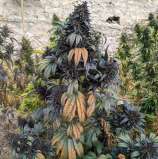Hopar Valley ’23 Selection #4
breed by Indian Landrace Exchange
Here you can find all info about Hopar Valley ’23 Selection #4 from Indian Landrace Exchange. If you are searching for information about Hopar Valley ’23 Selection #4 from Indian Landrace Exchange, check out our Basic Infos or Lineage / Genealogy for this cannabis variety here at this page and follow the links to get even more information. If you have any personal experiences with growing or consuming this cannabis variety, please use the upload links to add them to the database!
Basic / Breeders Info
Hopar Valley ’23 Selection #4 is an indica variety from I.L.E. and can be cultivated indoors (where the plants will need a flowering time of ±60 days), outdoors and in the greenhouse. I.L.E.s Hopar Valley ’23 Selection #4 is a THC dominant variety and is/was never available as feminized seeds.
I.L.E.s Hopar Valley ’23 Selection #4 Description

 Good yielding selection with intense purple colors from the Hopar Valley in Gilgit Baltistan, northern Pakistan. It features terpenes reminiscent of fresh pine paint thinner and mothballs. It has a short and closed structure with moderate lateral branching, completing its maturation in 8-9 weeks. The growing season spans from April/May to early October, when it is harvested to produce resin.
Good yielding selection with intense purple colors from the Hopar Valley in Gilgit Baltistan, northern Pakistan. It features terpenes reminiscent of fresh pine paint thinner and mothballs. It has a short and closed structure with moderate lateral branching, completing its maturation in 8-9 weeks. The growing season spans from April/May to early October, when it is harvested to produce resin.
Hopar Valley is a small bowl valley located at the toes of the Spantik and Hopar glacier. The indigenous population in Gilgit-Baltistan is known as “Balti” majority of whom are shia Muslims.
The cannabis cultivation in Hopar Valley has shrunk significantly in past 3-4 decades from being prolific to cannabis being a secondary crop which is now sown on the sides/periphery of the fields meant for growing food. Unlike, some of the other cannabis hotspots in northern pakistan like chitral, that saw an increasingly stringent attitude of the administration on Cannabis, Hopar Valley in the wake of rapidly increasing tourism had an entirely different reason for slowing down the cultivation of cannabis so, Cannabis can still be easily seen growing on sides of the roads in the entire valley, without a shred of worry.
In Hoper Valley, particularly, we observed that the farmers don’t plant cannabis as the main crop but every farmer plants the cannabis seeds as a side crop all along the fences of their fields reserved for their main crops like potatoes. As per the local farmers, they make exceptionally good use of the cannabis plant, by using the resin, the seeds for making traditional soups and the stems/stalks for burning to generate the life giving heat in the winter months.
The cannabis varieties which are adapted to such extremely cold weather conditions, embody certain features overtime, which are integral to the survival and the subsequent reproduction of the plant. These adaptations are typical and seen in plenty amongst the larger populations, Since, it’s these fine changes over the long periods of time that ultimately makes it conducive for the populations to thrive.
The first few adaptations which are quite apparent and can be subjectively appreciated in this valley, are the profuse anthocyanins production on the bracts only but not as often on the leaves itself and the relatively bigger size of the trichomes with a clearly more dense coverage as well.
The typical embodiment seen amongst the cannabis populations in the Valley is that of a semi-tall plant with moderate side branching, broad leaflets and fibrous stalk and stems similar to cannabis varieties domesticated in subtropical Highlands around 29-32°N (e.g. Malana, Uttrakhand, Nepal) but Hopar Valley being located at a Much higher latitude (36°N) have both lesser insolation (sun lit hours) and season length hence the plants in Hopar Valley have broader leaflets to absorb sufficient sunlight in shorter days and the plants also flower faster to finish before the onset of the snowfall. The plants at the most get 7-8 ft tall with much of the population staying under 6ft.
A lot of plants are also seen expressing vibrant colors mostly on the floral bracts, while some also showing anthocyanins production in leaves and the bracts alike. In fact there seems tobe a good proportion of plants expressing red/Purple coloration on the bracts with contrasting green leaves, within the larger domesticated population of Hopar Valley.
The un domesticated cannabis population in the Hopar Valley is distinctly different from the fully domesticated ones. E.g. plants from the un domesticated populations clearly show lesser vigor, sporting spindly stems instead of thick upright stalks as seen in domesticated populations here and the wilder genotypes also exhibits some of the typical characteristics seen amongst the wild or un domesticated Landrace populations of Cannabis such as shorter bract life to self disperse the seeds as shown in the picture below.
However, certain traits which are integral to the survival of the organism in this harsh terroir could be seen amongst both populations invariably, such as bigger sized trichomes can still be seen throughout every single plant in the valley be it domesticated or wild. It’s also, noteworthy that the smell found in these plants were a lot more intense in comparison to possibly any other known landrace variety encountered yet. The shear density of the resin glands on the flowers was outstanding in majority of the cases and the bigger size of those glands only seems to further aid in being able to produce and store higher volumes of (secondary metabolites) cannabinoids and terpenes.
Type: FIRST GENERATION (P1) LANDRACE STRAIN
Format: Regular
Sativa / Indica ratio: 100 % indica
Flowering outdoors: Early October.
Yield: High
Resistance against spider mites: Average
Resistance against powder mildew: Average
Resistance against botrytis: Average
Resistance against white fly: Average-High
Resistance against cold: High
Resistance against heat: High
Latitude: 0º-50º
Hopar Valley ’23 Selection #4 Lineage / Genealogy
- Hopar Valley ’23 Selection #4 »»» Northern Pakistan Indica
- Northern Pakistan Indica »»» Indica
Map of the Hopar Valley ’23 Selection #4 Family Tree
Click to show all parents of Hopar Valley ’23 Selection #4 in our dynamic family tree map.
Upload your info about this strain here:
Do you know something more about I.L.E.s Hopar Valley ’23 Selection #4? Please help to make this database better and upload/connect your information here!
Pictures
Pictures speak louder than words! Upload your "Hopar Valley ’23 Selection #4" Photos here and help other growers to get a better impression of this variety.
Comparisons
You have grown Hopar Valley ’23 Selection #4 together with another variety? Please fill out our Strain VS. Strain direct comparisation form!
User Reviews
Our strain reviews are multilingual, searchable and can be very detailed - including data about the grow, aroma, effects and taste! Please upload your Hopar Valley ’23 Selection #4 Review here to help the other seedfinder users!
Medical Values
You have experience with the medical qualities of Hopar Valley ’23 Selection #4? Sharing your information here maybe can help other people!
Threads
You've stumbled upon a Hopar Valley ’23 Selection #4 related thread into a forum or growers community? Connect it here and enable othe users to find this information fast and easy!
Videos
You found a related video with additional information or grow-infos about Hopar Valley ’23 Selection #4 on YouTube? Please connect it here to the strain info page!


